
Baseball is America’s pastime. There’s no doubt about that. The Major League Baseball organization we know today has existed for more than 100 years. That means MLB is older than any of the other professional sports leagues.
While more than half of today’s MLB teams share the league’s legendary longevity, most of the ballparks they call home do not. In fact, 24 of the league’s 30 teams play in ballparks that opened in 1989.
While technological advances have encouraged the building of more modern ballparks, oftentimes it comes at the expense of demolishing ballparks that have seen a century of historic games and iconic moments; not to mention concerts, professional fights, and, in some extreme cases, serious disasters.
In New York City alone, both Yankee Stadium and Shea Stadium; ballparks as synonymous with baseball as the players who play the game; were torn down within months of each other in favor of brand new ballparks built right next to or right on top of the old ones.
However, some cities maintain their ballparks in spite of their age or flaws. These few ballparks that have stood for generations are fixtures of baseball and American culture as a whole.
Kauffman Stadium – Kansas City, 1973
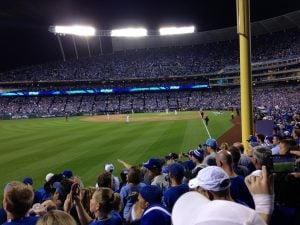
Once known as Royals Stadium, “The K” opened up in the fifth year of the Kansas City Royals’ existence as an expansion team and has been the home of the Blue Crew ever since.
Though it originally had a capacity of over 40,000, the number of seats was reduced during renovations in 2009 to 37,903. This left The K with the fifth-smallest capacity in MLB.
In 1993, the ballpark was renamed Kauffman Stadium in honor of the team’s original owner, Ewing Kauffman.
Many notable moments in MLB history have taken place at Kauffman Stadium:
- Nolan Ryan threw his first of an MLB-record seven no-hitters at the ballpark less than a month after its opening.
- In 1980, during the first World Series game ever played there, George Brett hit a home run in his first at-bat in a 4-3 win over the Philadelphia Phillies. Unfortunately, the Royals would lose the series in six games.
- In 1985, the Royals were back in the World Series and in Game 7 at Royals Stadium. This was following a 0-2 start to the series against the St. Louis Cardinals. An 11-0 win over the Cardinals at the ballpark sealed the Royals’ victory and became the first time in World Series history that a team overcame an 0-2 start to win the whole thing.

Kauffman Stadium is also noteworthy for being the only ballpark slinging their signature Sunrise Dog.
Introduced in 2017, this breakfast-inspired take on the ballpark staple starts with a griddled, foot-long frank and sliced Cheddar cheese on a buttery, toasted bun. Smother that with crispy bacon, rich sausage gravy, and a fried egg, and you’ve got yourself a Sunrise Dog.
Like hot dogs, bobbleheads are synonymous with baseball. If you want to learn about the history of these curious curios, check out our article, “The Fascinating History of the Bobblehead Doll.”
Angel Stadium – Anaheim, 1966
Formerly known as Anaheim Stadium and then Edison International Field of Anaheim, Angel Stadium has served as the home of the Los Angeles Angels of Anaheim for half a century in the city they share with Disneyland.
Founded in 1961 as an expansion team, the Angels played most of their first five years as a co-tenant of Dodger Stadium with the Los Angeles Dodgers before moving to Anaheim Stadium in 1966.
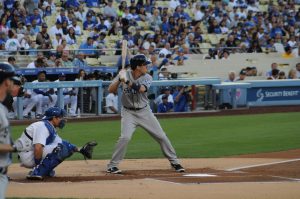
Like Kauffman Stadium, Angel Stadium has been its team’s home for the majority of their existence. The only difference is the number of times the Angels have rebranded themselves.
The team changed their name from the Los Angeles Angels to the California Angels after their move to the ballpark in 1966, then to the Anaheim Angels in 1997. In 2005, they changed their name to the Los Angeles Angels of Anaheim once again.
Angel Stadium currently has a capacity of well over 45,000 after adding several thousand more seats since its opening.
The ballpark has hosted seven American League Divisional Series and six American League Championship Series, along with the 2002 World Series, which the Angels won at Angel Stadium in Game 7 over the San Francisco Giants.
In addition to baseball, Angel Stadium has hosted high school and college football games, evangelists, and concerts from The Rolling Stones, The Who, and Pink Floyd, among others. From 1980 to 1994, the ballpark also served as the home of the NFL’s Los Angeles Rams.
Oakland Coliseum – Oakland, 1966
One of the more unique ballparks in the United States, the Oakland-Alameda County Coliseum was designed to support both a baseball team, the Oakland Athletics, and a football team, the Oakland Raiders.
The Oakland Coliseum was the site of the ninth perfect game in MLB history, a record achieved by Catfish Hunter in the A’s first year there. In 1972, the A’s won the first of three straight World Series titles at the Coliseum.
Unfortunately, the Coliseum is not without its drawbacks. The stadium’s foul territory is widely considered to be too big, for instance. As a result, it allows for more foul outs than most other ballparks.
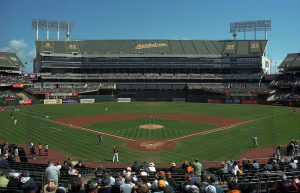
An upper deck expansion of 10,000 seats done in 1996 by Oakland Raiders owner Al Davis is also criticized for messing up the ambiance of the venue by making it look too much like a football stadium.
Between the artificially limited seating capacity for baseball games and many issues both in and around the ballpark, speculation has raged for years that the stadium would be, at the very least, abandoned, if not torn down and replaced by the two teams.
In recent years, the Raiders and current owner Mark Davis have become so fed up with the conditions at the Oakland Coliseum that they have explored options for relocation. They most recently earned approval for a stadium to be constructed in Las Vegas, Nevada.
The A’s have also considered building a new venue, alluding to the possibility that the Oakland Coliseum won’t be on this list for much longer…
Dodger Stadium – Los Angeles, 1962
With a capacity of 56,000, Dodger Stadium is by far the biggest ballpark in Major League Baseball. For comparison, it features over 5,000 seats more than the Colorado Rockies’ Coors Field in Denver, which is the second-largest ballpark in the league.
Ground broke on Dodger Stadium in 1959 after the Brooklyn Dodgers announced their move to Los Angeles. The team spent several years at the Los Angeles Memorial Coliseum before Dodger Stadium opened in 1962.
In the decades since the move, a historic 12 no-hitters and two perfect games have been pitched at Dodger Stadium, with three of those coming from Dodgers legend Sandy Koufax in the 1960s.
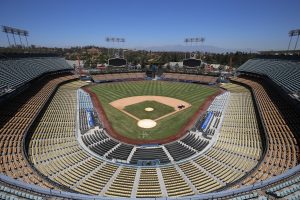
Unlike many teams who struggle to bring their winning ways with them to a new city, the Dodgers had no trouble continuing their legacy in Los Angeles, winning three pennants in the first five years at Dodger Stadium.
In 1963, the Dodgers won the World Series at Dodger Stadium with a sweep against the New York Yankees. This was the third of the teams six world titles. Ironically, 1963 remains the only year in which the Dodgers claimed the title at home.
Over the years, acclaimed artists such as The Beatles, David Bowie, Elton John, The Jackson 5, and Kiss have performed at Dodger Stadium as well.
Wrigley Field – Chicago, 1914
Now we move from the Baby Boomer ballparks to the oldest ones in MLB, starting with Wrigley Field, the home of the once-cursed, now-World Series champion Chicago Cubs.
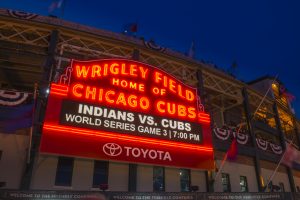
Wrigley Field has a capacity of 41,268. It features ivy-covered outfield walls, a hand-turned scoreboard, and its original main entrance marquee, which was restored in 2016.
For the better part of the 108-year “curse,” Wrigley Field and its 41,268-seat capacity was the site of far more heartbreak than happiness. The 2003 Steve Bartman incident that occurred at the ballpark in Game 6 of the NLCS between the Cubs and the Florida Marlins is one of the most recent and infamous moments in the ballpark’s longstanding lore.
Though the Cubs have three World Series titles under their belt, the title-winning game has never taken place at Wrigley Field.
Wrigley Field also hosted the NFL’s Chicago Bears from 1921 to 1970, along with several defunct or relocated sports franchises. The 2009 NHL Winter Classic was played at Wrigley Field and ended in a Chicago Blackhawks loss to the Detroit Red Wings.
The ballpark began hosting live concerts in 2005. Musical legends AC/DC, Pearl Jam, and the Foo Fighters are among those who have performed at Wrigley Field.
If you’re planning to visit Chicago to attend a game at Wrigley Field, consider staying at the newly opened Hotel Zachary. Located right across the street from the ballpark, Hotel Zachary is a home run for Cubs fans.
Interested in learning about other fan-friendly hotels near ballparks and other sports venues in cities like Orlando, Atlanta, and Dallas? Check out our article “Top 5 Fan-tastic Hotels for Sports Fans.”
Fenway Park – Boston, 1912
Perhaps no venue in baseball, or all of sports, for that matter, is as much a monument to the early days of baseball as Fenway Park. The century-old home of the Boston Red Sox has become not only an iconic ballpark, but a celebrated American landmark.
After 10 years of playing at the Huntington Avenue Grounds from 1901 to 1911, team owner John I. Taylor purchased the land needed to build a brand new ballpark for the Red Sox. After breaking ground on September 25, 1911, Fenway Park opened less than seven months later.

The Green Monster, “The Triangle,” “Williamsburg,” the lone red seat, and Pesky’s Pole are some of the ballpark’s famous features. Even to first-time visitors, Fenway Park looks as game-ready as any other ballpark in the country.
Over the years, Fenway Park has undergone many renovations to improve and update, rather than replace, many of the more nostalgic parts of the ballpark.
Constraints on land availability have made expansion difficult, though. It’s one of the many reasons why Fenway Park has not been able to expand beyond a capacity of 40,000. To date, Fenway Park maintains one of the lowest capacities among MLB ballparks.
The multitude of pro football teams that tried to establish a market in Boston typically used Fenway Park. Even the Boston Patriots, now known as the New England Patriots, occupied it from 1963 to 1968.
Fenway Park has hosted five of the eight World Series title wins for the Boston Red Sox, along with 20 soccer matches, several college football games, and concerts by Paul McCartney, Ray Charles, Stevie Wonder, Bruce Springsteen, and Billy Joel.
